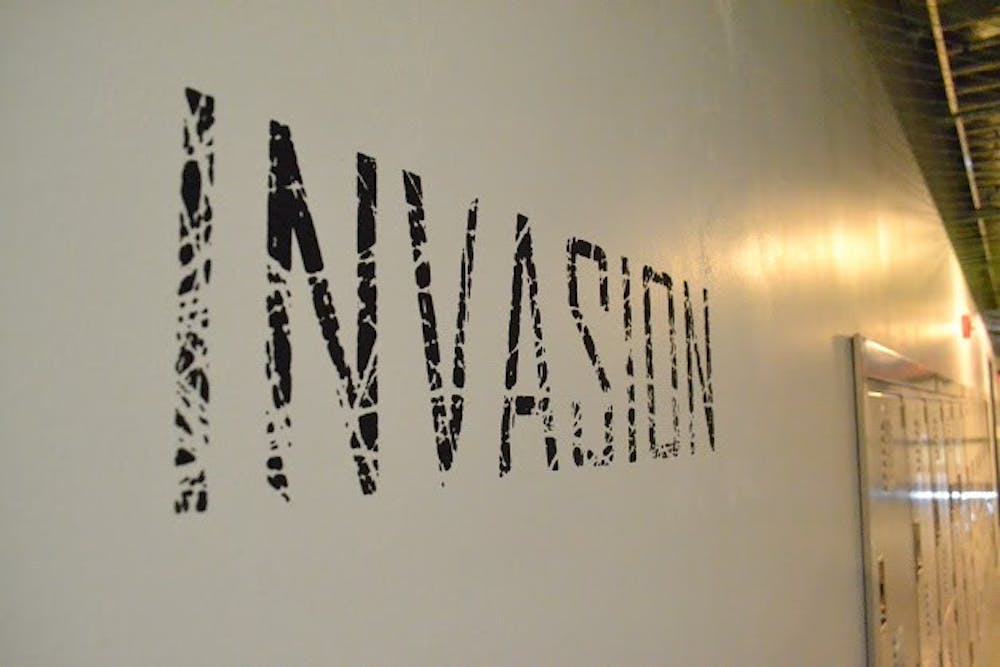By Roderick Macioch
Staff Writer
If you don’t know what you’re looking at, you may think you have stumbled into the wrong room, or that you’re in the right room but the art is missing. When you look at the floor, you notice black streaks running across it. At first it looks like an accident — but this is no accident. This is installment art, and the room itself is the art.
In conjunction with the faculty art exhibition “Fluctuations” currently on display in the Arts and Interactive Multimedia Building art gallery, the installment art of three student artists is also on display now through Sunday, Oct. 11, in rooms 111, 118 and 119.
The three student artists being showcased, seniors Amanda Intili and Jessica Hargwood and junior Joe Arnold, have each been selected by the Art Department to present an example of installment art. The exhibition had a lengthy application process, which involved presenting ideas to the Art Department in the form of written descriptions, sketches and models.
The installment featuring the black streaks along the floor is entitled “Invasion,” and was created by Intili, an art education major. This is her second solo exhibition at the College.
Installment art, also known as installation art, as explained by Intili, aims to “take an entire space into consideration” to make it “more like an experience.”

As opposed to a painting, for instance, installment art is more interactive. Rather than just a space on a wall, the wall becomes part of the artwork. Instead of just looking at the piece, the observer walks into it and can be surrounded, even engulfed by it.
Intili says her piece is intended to “play with the idea of comfort” and create a “subtle disturbance.” However, Intili feels the piece cannot be explained in any simple terms, or confined by making any single statement.
“It touches on a lot of things,” she said.
It can, for instance, be a commentary on society’s perception of hair.
“If hair is on someone’s head it is considered beautiful,” Intili said. “But in a drain or on another part of the body it becomes taboo.”
However one may interpret it, Intili says the piece “continues to test the viewer’s comfort level through material choices.”
Lens-based art major Joe Arnold’s installment entitled “Built Environment” “uses installation to investigate the ideas of the built and artificial environments in an already existing man-made space,” according to the exhibition’s Web page. It consists of 10 squares of various sizes that offer distorted reflections at different angles. The blue and green fluorescent lighting interacts with these reflections, making it all at once disorienting and cohesive.

A program quotes Arnold’s own interpretation of the piece as “a material, spatial and cultural product of human labor that combines physical elements and energy.”
Hargwood, a fine art major, presented her first solo exhibition, a fiber installation entitled, “My Overt Blackness.” The piece “explores the complexities of biracial identity through light and color,” Hargwood said.
In her own words, Hargwood designed the piece as a visual representation of her “biracial identity and how being biracial affects my views on society and how society views me.”
“My Overt Blackness” consists of pieces of tulle netting strung across the room like a web.
“You can see through it depending on the layers,” Hargwood said about the appeal of the medium. “It shows the relationship of colors intertwining in the space.”
When asked how the artist could know when a piece so abstract is finished, Intili said “You get to a point when you just feel like you can part with it.”
“Or when you can’t stand looking at it any more” laughed Hargwood, recalling the countless hours all three spent bringing their artistic visions to fruition.
The downside to this type of art is that, in this case, it can only exist temporarily. Unlike a statue, which can last for centuries, these pieces will be dismantled after the exhibition closes on Sunday, Oct. 11. So see them, or rather, become a part of them while you can.







